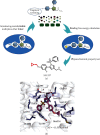Distribution- and Metabolism-Based Drug Discovery: A Potassium-Competitive Acid Blocker as a Proof of Concept
- PMID: 35958113
- PMCID: PMC9343080
- DOI: 10.34133/2022/9852518
Distribution- and Metabolism-Based Drug Discovery: A Potassium-Competitive Acid Blocker as a Proof of Concept
Abstract
Conventional methods of drug design require compromise in the form of side effects to achieve sufficient efficacy because targeting drugs to specific organs remains challenging. Thus, new strategies to design organ-specific drugs that induce little toxicity are needed. Based on characteristic tissue niche-mediated drug distribution (TNMDD) and patterns of drug metabolism into specific intermediates, we propose a strategy of distribution- and metabolism-based drug design (DMBDD); through a physicochemical property-driven distribution optimization cooperated with a well-designed metabolism pathway, SH-337, a candidate potassium-competitive acid blocker (P-CAB), was designed. SH-337 showed specific distribution in the stomach in the long term and was rapidly cleared from the systemic compartment. Therefore, SH-337 exerted a comparable pharmacological effect but a 3.3-fold higher no observed adverse effect level (NOAEL) compared with FDA-approved vonoprazan. This study contributes a proof-of-concept demonstration of DMBDD and provides a new perspective for the development of highly efficient, organ-specific drugs with low toxicity.
Copyright © 2022 Ming-Shu Wang et al.
Conflict of interest statement
The authors declare no competing financial interest.
Figures





Similar articles
-
Characteristics of the Novel Potassium-Competitive Acid Blocker Vonoprazan Fumarate (TAK-438).Adv Ther. 2016 Jul;33(7):1140-57. doi: 10.1007/s12325-016-0345-2. Epub 2016 Jun 10. Adv Ther. 2016. PMID: 27287852 Review.
-
Vonoprazan fumarate, a novel potassium-competitive acid blocker, in the management of gastroesophageal reflux disease: safety and clinical evidence to date.Therap Adv Gastroenterol. 2018 Jan 9;11:1756283X17745776. doi: 10.1177/1756283X17745776. eCollection 2018. Therap Adv Gastroenterol. 2018. PMID: 29383028 Free PMC article. Review.
-
The First-in-Class Potassium-Competitive Acid Blocker, Vonoprazan Fumarate: Pharmacokinetic and Pharmacodynamic Considerations.Clin Pharmacokinet. 2016 Apr;55(4):409-18. doi: 10.1007/s40262-015-0326-7. Clin Pharmacokinet. 2016. PMID: 26369775 Review.
-
Short-term efficacy of potassium-competitive acid blocker following gastric endoscopic submucosal dissection: a propensity score analysis.Scand J Gastroenterol. 2018 Feb;53(2):243-251. doi: 10.1080/00365521.2017.1410569. Epub 2017 Dec 7. Scand J Gastroenterol. 2018. PMID: 29214885
-
Severe Hypomagnesemia Associated with the Long-term Use of the Potassium-competitive Acid Blocker Vonoprazan.Intern Med. 2022 Jan 1;61(1):119-122. doi: 10.2169/internalmedicine.7325-21. Epub 2021 Jun 26. Intern Med. 2022. PMID: 34176835 Free PMC article.
Cited by
-
INTEDE 2.0: the metabolic roadmap of drugs.Nucleic Acids Res. 2024 Jan 5;52(D1):D1355-D1364. doi: 10.1093/nar/gkad1013. Nucleic Acids Res. 2024. PMID: 37930837 Free PMC article.
-
Clinical pharmacokinetics of potassium competitive acid blockers: a systematic review and meta-analysis.Front Pharmacol. 2025 Jul 8;16:1580969. doi: 10.3389/fphar.2025.1580969. eCollection 2025. Front Pharmacol. 2025. PMID: 40697654 Free PMC article.
References
-
- Sharma A., Mittal K., Arora D., Ganti S. S. A comprehensive review on strategies for new drug discovery and enhanced productivity in research and development: recent advancements and future prospectives. Mini-Reviews in Organic Chemistry . 2021;18(3):361–382. doi: 10.2174/1570193X17999200529100808. - DOI
LinkOut - more resources
Full Text Sources

